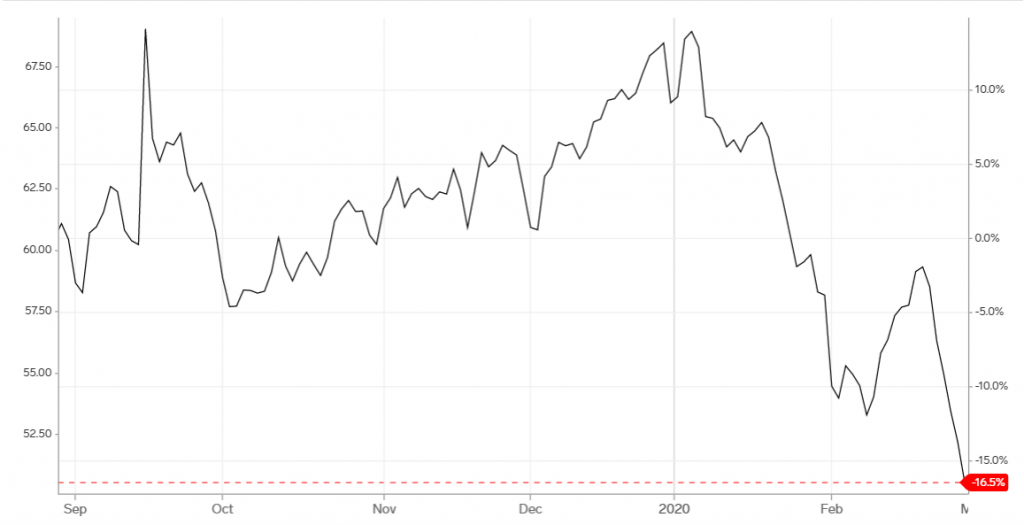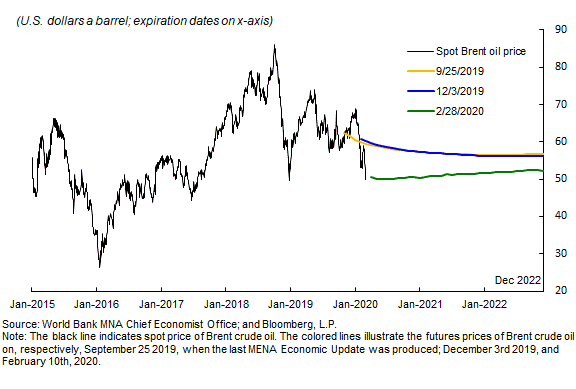In a nutshell
Because of their exposure to oil and gas exports, a decline in the prices of petroleum-related products is expected to be the most significant channel through which effects of the COVID-19 are felt in MENA countries.
Disruptions to global value chains might exacerbate the depression of oil prices caused by China’s weakening demand since the discovery of the new virus and infections at the beginning of 2020.
The recovery of oil prices will depend on how successfully China and other countries control the spread of the virus, the effects of which are becoming increasingly global.
The novel coronavirus (COVID-19) was first alerted to the World Health Organization (WHO) by the Chinese authorities on 31 December 2019. This new virus can cause flu-like symptoms, which often are more severe and more likely to result in death than other known coronaviruses.
The virus has spread to more than 95 countries and territories, with over 100,000 cases and close to 3,500 deaths (as of 6 March 2019). It has the potential to lead to severe disruption of global economic activities. In this column, which is a chapter in the new VoxEU/CEPR publication Economics in the Time of COVID-19, we examine the channels through which COVID-19 may affect the Middle East and North Africa (MENA) region.
COVID-19 infections
Travellers from China, Korea, Italy and other affected countries could spread COVID-19 to the MENA region. The virus has already spread to Iran and other MENA countries. As of 6 March, Iran had reported over 4,500 infections and at least 43 deaths. The rapid rise in infections there is likely to disrupt the country’s production and trade. As the virus spread in Iran, authorities closed schools and cancelled art and film events, and neighbouring countries closed their land borders with Iran.
Other MENA countries have also reported infections. As of 6 March, the United Arab Emirates had reported 28 cases, Iraq had reported 40 cases, Bahrain had reported 60 cases and Kuwait had reported 58 cases. Egypt, Lebanon and Qatar have also reported their first cases.
The ability to contain the virus depends on the strength of the public health systems of the MENA countries. WHO ranks most MENA countries relatively high among the world’s 191 health systems – with a few exceptions, such as Yemen, ranked 120th, and Djibouti, ranked 157th (Tandon et al, 2000).
But some MENA countries might face difficulties in fighting the spread of the virus. Wars in Syria and Yemen will almost certainly impede the proper functioning of the health systems in the two countries. According to Abdinasir Abubakar of WHO’s Regional Office for the Eastern Mediterranean, the US embargo may hurt Iran’s ability to buy the technology required to produce essential equipment and medicine.
Oil prices
Because of their exposure to oil and gas exports, a decline in the prices of petroleum-related products is expected to be the most significant channel through which effects of the COVID-19 are felt in MENA countries.
Since the discovery of the new virus and infections in China at the beginning of 2020, oil prices have declined sharply. The price of Brent oil dropped from $68.90 a barrel on 1 January to $50.5 a barrel as of 28 February (see Figure 1). Crude oil futures tumbled by about $20 a barrel during January and February in anticipation of the negative impact on oil demand from COVID-19 (see Figure 2).
Although other factors might have contributed to this drop, COVID-19 was probably the most important factor, largely because of the significant drop in demand from China as authorities shuttered production facilities as part of their efforts to contain the spread of the virus. According to the Oil Market Report for February from the International Energy Agency (IEA), China’s oil demand currently accounts for 14% of global demand, and China’s growth in oil demand currently accounts for more than 75% of the global growth in demand (International Energy Agency, 2020).
In addition, with an increasingly important role in the global economy, any setbacks to the Chinese economy are expected to have significant negative spillovers to the global economy (Arezki and Yang, 2018). The global fear and uncertainty regarding the spread of virus is likely to hurt investment decisions in China and in other countries, which further lowers oil prices.
The IEA expects global demand for oil to fall by 435,000 barrels per day year-on-year in the first quarter of 2020 – the first quarterly contraction in more than a decade. The global demand for all of 2020 is also expected to fall by 365,000 barrels per day – the worst performance of demand since 2011.
The risk posed by the COVID-19 crisis has prompted the OPEC+ countries to consider an additional cut in oil production of 600,000 barrels a day as an emergency measure on top of the 1.7 million barrels a day already pledged (International Energy Agency, 2020).
The recovery of oil prices will depend on how successfully China and other countries control the spread of the virus, the effects of which are becoming increasingly global. Although the vast majority of cases have been in China, Korea, Italy and Iran have seen a surge in infections and many other countries have recorded some cases.
Figure 1: Brent oil price and future curves
Note: Data end on 28 February 2020
Figure 2: Oil price futures
Note: The colour lines show the future prices of Brent crude oil on 25 September 2019, 3 December 2019 and 28 February 2020.
Value chains
When China’s production is disrupted, countries with strong value chain connections with China are likely to be affected. This is a special concern for many Asian countries, which have important value chain connections with China, but less likely to be a concern for MENA countries, which have limited participation in global value chains. But disruptions to global value chains might exacerbate the depression of oil prices caused by China’s weakening demand.
Tourism and travel
COVID-19 is likely to reduce tourism from China to MENA in two ways. The first is the pull factor: many MENA countries are now imposing travel restrictions on Chinese people. In addition, Saudi Arabia suspended entry of pilgrims to the holy sites, further reducing tourism to the Middle East.
The second is the push factor: economic slowdown in China implies fewer tourists travelling to other countries, including MENA. The East Asia and Pacific region is likely see the sharpest drop in Chinese tourists. The effect of economic slowdown in China on tourist arrivals to MENA is expected to be more limited (see Figure 3). But the reduction of global travel will further depress oil prices.
Figure 3: Estimated impact of a decline in China’s per capita GDP on Chinese arrivals to MENA and the rest of the world
Source: Lopez-Cordova (2020a, 2020b).
Further reading
Arezki, R, and L Yang (2018) ‘On the Asymmetry of Global Spillovers: Emerging Markets Versus Advanced Economies’, World Bank Policy Research Working Paper WPS8662.
International Energy Agency (2020) Oil Market Report February 2020.
Lopez-Cordova, E (2020a) ‘A Slowdown of China’s Economy and its Impact on the Demand for Tourism Services’, Brief.
Lopez-Cordova, E (2020b) ‘Digital Platforms and the Demand for International Tourism Services’, World Bank Policy Research Working Paper WPS9147.
Tandon A, CJ Murray, JA Lauer and D Evans (2000) ‘Measuring overall health system performance for 191 countries’, World Health Organization, Geneva.
A version of this column is a chapter in the new VoxEU/CEPR publication Economics in the Time of COVID-19, edited by Richard Baldwin and Beatrice Weder di Mauro.






